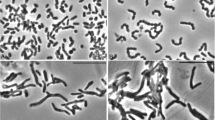Abstract
Bioremediation potential of bacteria and fungi isolated from sludge samples has been investigated (Danube alluvium, Pančevo, Serbia). Total isolated microorganisms were divided into three parts. One part was added with actidione antifungicide. The second part was added with streptomycin antibiotic. The third part was without additives. Paraffinic type of crude oil was a substrate for assessment of bioremediation potential. The simulated oil biodegradation lasted 30, 60 and 90 days. Parallel with that, the experiments with blind trial were conducted. Extracts were isolated from the samples with chloroform in a separate funnel. They were assayed for the group composition (alkanes, aromatics, alcohols and fatty acids) by column chromatography. Alkane fraction was analysed by gas chromatography—mass spectrometry (GC–MS). The most intense oil degradation was achieved in the experiments with bacteria, somewhat weaker with consortium of fungi and bacteria, and the weakest bioremediation potential in these experiments was shown by fungi.




Similar content being viewed by others
References
Al-Hadhrami MN, Lappin-Scott HM, Fisher PJ (1997) Studies on the biodegradation of three groups of pure n-alkanes in the presence of molasses and mineral fertilizer by Pseudomonas aeruginosa. Mar Pollut Bull 34:969–974. doi:10.1016/S0025-326X(97)00066-0
Antić M, Jovančićević B, Ilić M, Vrvić MM, Schwarzbauer J (2006) Petroleum pollutant degradation by surface water microorganisms. Environ Sci Pollut Res 13:320–327. doi:10.1065/espr2006.03.296
Collins CH, Lyne PM, Grange JM, Falkinham JO (2004) Microbiological methods. Arnold, London
Ezra S, Feinstein S, Pelly I, Baumen D, Miloslavsky I (2000) Weathering of fuel oil spill on the east Mediterranean coast, Ashdod, Israel. Org Geochem 31:1733–1741. doi:10.1016/S0146-6380(00)00091-7
Head IM, Jones DM, Larter S (2003) Biological activity in the deep subsurface and the origin of heavy oil. Nature 426:344–352. doi:10.1038/nature02134
Isikhuemhen O, Anoliefo G, Oghale O (2003) Bioremediation of crude oil polluted soil by the white rot fungus pleurotus tuberregium (Fr.) Sing. Environ Sci Pollut Res 10:108–112. doi:10.1065/espr2002.04.114
Jovančićević B, Polić P, Vrvić M, Sheeder G, Teschner T, Wehner H (2003) Transformations of n-alkanes from petroleum pollutants in alluvial ground waters. Environ Chem Lett 1:73–81. doi:10.1007/s10311-002-0002-7
Jovančićević B, Antić M, Šolević T, Vrvić M, Kronimus A, Schwarzbauer J (2005) Investigation of interactions between surface water and petroleum type pollutant. Environ Sci Pollut Res 12:205–212. doi:10.1065/espr2004.12.229
Jovančićević B, Antić M, Vrvić M, Ilić M, Novaković M, Saheed RM, Schwarzbauer J (2008) Transformation of petroleum pollutant during soil bioremediation experiments. J Serbian Chem Soc 73:601–607
Löser C, Seidel H, Zehnsdorf A, Stottmeister U (1998) Microbal degradation of hydrocarbons in soil during aerobic/anaerobic changes and under purely aerobic condition. Appl Microbiol Biotechnol 49:631–636. doi:10.1007/s002530051225
Oudot J, Merlin FX, Pinvidic P (1998) Weathering rates of oil components in a bioremediation experiment in estuarine sediment. Mar Environ Res 45:113–125. doi:10.1016/S0141-1136(97)00024-X
Peters KE, Walters JM, Moldowan JM (2005) The Biomarker guide: biomarkers and isotopes in the petroleum exploration and earth history vol 2. Cambridge University Press, Cambridge
Readman JW, Bartocci J, Tolosa I, Fowler SW, Oregioni B, Abdulraheem MY (1996) Recovery of the coastal marine environment in the Gulf following the 1991 war-related oil spills. Mar Pollut Bull 32:493–498. doi:10.1016/0025-326X(95)00227-E
Rosa AP, Trigüis JA (2007) Bioremediation process on brazil shoreline. Laboratory experiments. Environ Sci Pollut Res 14:470–476. doi:10.1065/espr2007.02.377
Tissot BP, Welte DH (1984) Petroleum formation and occurrence. Springer, New York
Volkman JK, Alexander R, Kagi RI, Woodhouse GW (1983) Demethylated hopanes in crude oils and their applications in petroleum geochemistry. Geochim Cosmochim Acta 47:785–794. doi:10.1016/0016-7037(83)90112-6
Acknowledgments
We thank the Alexander von Humboldt Foundation and the Ministry of Science and Technological Development of the Republic of Serbia (Projects: 146008 & 142018) for supporting this research.
Author information
Authors and Affiliations
Corresponding author
Rights and permissions
About this article
Cite this article
Ilić, M., Antić, M., Antić, V. et al. Investigation of bioremediation potential of zymogenous bacteria and fungi for crude oil degradation. Environ Chem Lett 9, 133–140 (2011). https://doi.org/10.1007/s10311-009-0257-3
Received:
Accepted:
Published:
Issue Date:
DOI: https://doi.org/10.1007/s10311-009-0257-3




